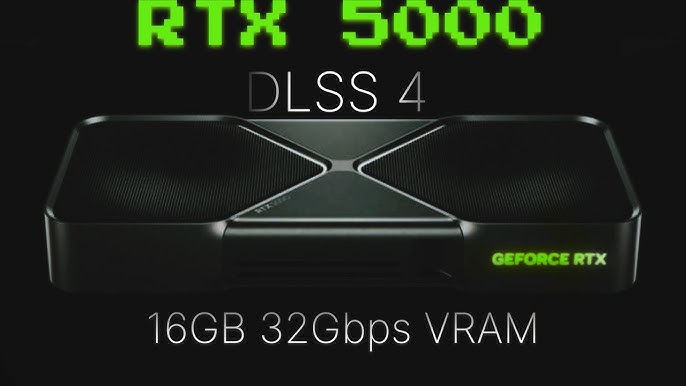NVIDIA RTX 50 Series: A New Dawn for PC Graphics
1/11/2025NVIDIA RTX 50 Series: A New Dawn for PC Graphics

The GPU market is on the brink of a seismic shift with NVIDIA's announcement of the RTX 50 series at CES 2025. Here's what we know about the SKUs, specs, and pricing, alongside how they stack up against AMD's RDNA 4 Radeon RX 9000 series and Intel's Arc B-series GPUs.
NVIDIA RTX 50 Series Overview:
-
RTX 5090:
-
CUDA Cores: 21,760
-
Memory: 32GB GDDR7
-
TDP: 575W
-
Price: $1,999
-
Launch: January 30, 2025
-
This flagship is designed to outstrip its predecessor, the RTX 4090, with significant boosts in AI performance and ray tracing capabilities, thanks to the new Blackwell architecture.
-
-
RTX 5080:
-
CUDA Cores: 10,752
-
Memory: 16GB GDDR7
-
TDP: 360W
-
Price: $999
-
Launch: January 30, 2025
-
Aimed at high-performance gamers, it promises double the performance of the RTX 4080.
-
-
RTX 5070 Ti:
-
CUDA Cores: 8,960
-
Memory: 12GB GDDR7
-
Price: $749
-
Launch: February 2025
-
This card targets enthusiasts looking for performance without the premium price tag.
-
-
RTX 5070:
-
CUDA Cores: 6,144
-
Memory: 12GB GDDR7
-
Price: $549
-
Launch: February 2025
-
Positioned for gamers seeking the latest tech at a more budget-friendly price.
-

The RTX 50 series introduces NVIDIA's DLSS 4 technology, which uses AI to substantially enhance frame rates, making high-end gaming more accessible.
AMD RDNA 4 Radeon RX 9000 Series:
AMD's strategy with the RX 9000 series, powered by RDNA 4 architecture, is notably different, focusing primarily on the mid-range market:
-
RX 9070 XT:
-
Cores: Up to 4,096
-
Memory: 16GB GDDR7
-
TBP: Around 260W
-
Price: Expected around $1,097
-
Launch: Q1 2025
-
Designed to compete with NVIDIA's RTX 5070 in terms of performance but at a potentially higher price point.
-
-
RX 9070:
-
Cores: Details less clear but likely less than XT variant
-
Memory: Expected 16GB GDDR7
-
Price: Around $912
-
Launch: Q1 2025
-
A step down from the XT, still aiming for strong mid-tier performance.
-
AMD's approach seems to be about offering value in the mid-range segment, with no direct high-end competitors to NVIDIA's RTX 5090 or 5080. The RX 9070 series focuses on efficiency and AI enhancements, with new FSR 4 technology for upscaling.
Intel Arc B-Series GPUs:
Intel is also stepping up its game with the Arc B-series:
-
Arc B580:
-
Cores: Not specified, but known for significant performance improvements
-
Memory: 12GB GDDR6
-
Price: $249
-
Launch: Early 2025
-
This GPU has been a hit in the budget segment, offering good performance for the price.
-
-
Arc B570:
-
Similar specs to B580 but with a slightly lower price point
-
Price: $219
-
Launch: January 16, 2025
-
Aimed at budget-conscious gamers, providing a competitive edge against AMD and NVIDIA in terms of cost-efficiency.
-
Intel's Arc GPUs are making strides in driver stability and performance, particularly in the budget to mid-range market, where they offer competitive VRAM capacities.
Comparison and Market Dynamics:
-
Performance: NVIDIA's RTX 50 series seems to take the lead in raw performance, especially at the high end. The RTX 5090 and 5080 have no direct competitors from AMD or Intel in terms of sheer power and AI capabilities.
-
Pricing: NVIDIA's pricing reflects its dominance in performance at the top, while AMD and Intel are positioning themselves more competitively in the mid and lower segments. AMD's RX 9070 series might struggle price-wise against NVIDIA's offerings if performance doesn't match expectations.
-
Market Strategy: NVIDIA continues to push the boundaries of what's possible in gaming and AI, while AMD focuses on market segments where it can offer value. Intel, still new to the GPU game, is carving out a niche in budget performance.
-
Technology: NVIDIA's DLSS 4, AMD's FSR 4, and Intel's XeSS upgrades all aim at enhancing gaming experiences through AI, but NVIDIA's tech currently leads in terms of adoption and performance gains.
Conclusion:
The RTX 50 series from NVIDIA sets a new performance benchmark, particularly for high-end users. AMD's RDNA 4 might not compete at the top but could redefine value in the mid-range, while Intel's Arc B-series continues to push for budget-friendly high-performance options. This lineup of new GPUs from the big three promises an exciting year for PC gaming, with each manufacturer bringing unique strengths to the table.

